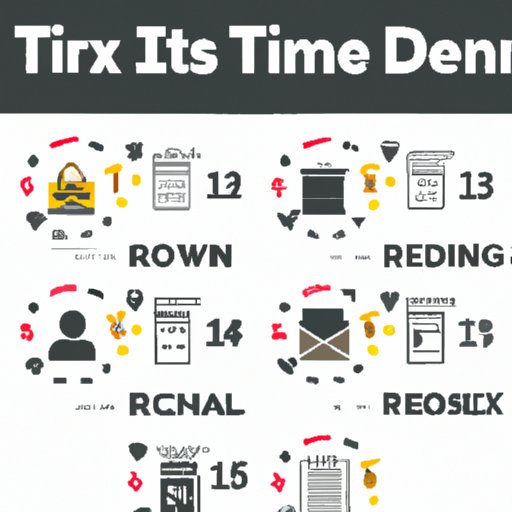Introduction
Tax season is an exciting time for many—it’s the moment when you can finally receive your hard-earned money from the government in the form of a tax refund. However, understanding how long it will take to get your refund can be confusing. In this article, we’ll explore the timeline for receiving a tax refund and discuss the factors that can impact how quickly you receive your money.

Breaking Down the Average Time for Receiving a Tax Refund
In general, it usually takes between three to four weeks to receive your federal tax refund. However, the timeline can vary depending on a number of factors. For example, if you file your taxes electronically, you may receive your refund more quickly than if you submit a paper return. Additionally, if there are any errors or omissions in your filing, you may need to wait longer for your refund as the Internal Revenue Service (IRS) reviews your return.

Exploring Factors That Impact How Long You Have to Wait for Your Tax Refund
There are several factors that can affect the timeline for receiving your tax refund. Let’s take a closer look at each one:
Filing Method
If you file your taxes electronically, you may receive your refund more quickly than if you file a paper return. The IRS recommends e-filing as it’s faster and more accurate than filing a paper return. Additionally, if you choose to have your refund deposited directly into your bank account, you may receive your refund even faster.
Processing Time
The amount of time it takes for the IRS to process your return can also affect the timeline for receiving your refund. Generally, if you file electronically, you can expect to receive your refund within 21 days. If you file a paper return, it may take up to six weeks or longer to receive your refund.
Errors in Filing
If there are any errors or omissions in your filing, the IRS may need to review your return, which can delay the timeline for receiving your refund. To avoid any delays, make sure to double check your return before submitting it.

Understanding the Timelines for Different Types of Tax Refunds
The timeline for receiving a tax refund can vary depending on the type of refund you are requesting. Let’s take a look at the timelines for two common types of refunds: federal tax refunds and state tax refunds.
Federal Tax Refunds
For federal tax refunds, you can typically expect to receive your refund within three to four weeks. However, if you file your return electronically and choose to have your refund deposited directly into your bank account, you may receive your refund even faster.
State Tax Refunds
The timeline for receiving a state tax refund can vary depending on the state. Generally, you can expect to receive your refund within six to eight weeks. It’s important to note that some states may have different timelines for receiving a refund, so make sure to check with your state’s tax department for more information.

What to Do if Your Tax Refund is Delayed
If your tax refund is delayed, there are a few steps you can take to find out what’s causing the delay. First, you should contact the IRS to inquire about the status of your refund. You can also check the status of your refund online by using the “Where’s My Refund?” tool on the IRS website.
Analyzing the Benefits of Filing Your Taxes Early
Filing your taxes early has a number of benefits, including faster processing times and increased accuracy. Additionally, filing early can help ensure that you receive your refund sooner rather than later. So, if you’re looking to get your refund as quickly as possible, make sure to file your taxes as soon as you can.
Examining the Steps Involved in Getting Your Tax Refund
Receiving a tax refund involves several steps. First, you must submit your taxes to the IRS. Then, you must apply for your refund by either filing a paper return or e-filing. Finally, once the IRS has processed your return, you will receive your refund in the form of a check or direct deposit.
Tips for Increasing the Speed of Your Tax Refund
There are a few things you can do to increase the speed of your tax refund. First, you should consider filing your taxes electronically. Electronic filing is faster and more accurate than filing a paper return. Additionally, make sure to include all necessary information and double check for errors to ensure that your refund is processed quickly.
Conclusion
In conclusion, understanding the timeline for receiving a tax refund is important. Generally, you can expect to receive your federal tax refund within three to four weeks. There are several factors that can affect the timeline, including filing method, processing time, and errors in filing. Additionally, the timeline for receiving a state tax refund can vary depending on the state. If your tax refund is delayed, make sure to contact the IRS and check the status of your refund. Finally, filing your taxes early can help you receive your refund faster.
(Note: Is this article not meeting your expectations? Do you have knowledge or insights to share? Unlock new opportunities and expand your reach by joining our authors team. Click Registration to join us and share your expertise with our readers.)
